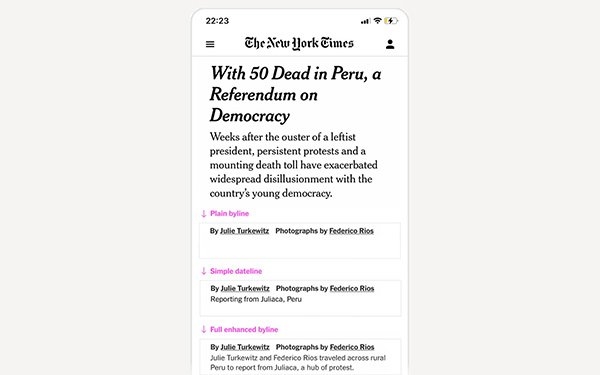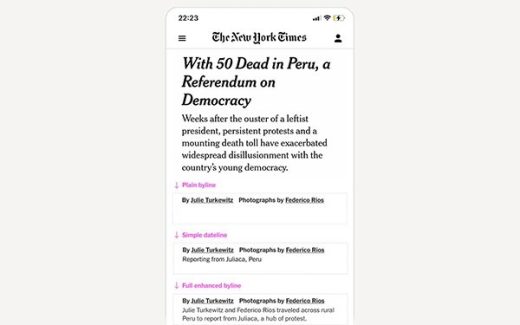‘New York Times’ Launches ‘Enhanced’ Bylines For Online Stories
‘New York Times’ Launches ‘Enhanced’ Bylines For Online Stories

The New York Times
has updated the way its reporters’ bylines will appear for some online stories reported outside of New York.
Instead of a traditional dateline stating where a story is reported from, readers will now see enhanced bylines informing them about how journalists carried out their reporting.
“Instead of ‘WASHINGTON —’ in the lead on our next article from the White House or Capitol Hill, we will write “Reporting from Washington” in an enhanced byline, or include a reference to the location in a broader description of the reporting effort,” explain Managing Editor Marc Lacey and Assistant Managing Editor Matt Ericson in an email sent to the Times newsroom on Thursday.
The Times has been considering enhanced bylines for several years. According to Edmund Lee, an assistant editor on the Times’ Trust team, internal research has found readers trust journalism more when they are informed about how what they are reading was produced.
Lee went on to explain that readers are often unaware that reporters are on the ground in the place mentioned in the dateline. “A big part of ensuring trust is letting people know we are where we say we are,” he added.
Several enhanced bylines can be seen at once in a co-reported story from Friday about the Coast Guard of Greece abandoning asylum seekers on a raft in the Aegean Sea:
“Matina Stevis-Gridneff reported from Brussels and Athens, and traveled to Izmir in Turkey with Nimet Kirac to interview the group of migrants. Sarah Kerr and Kassie Bracken reported from New York. Riley Mellen and Christopher F. Schuetze contributed reporting. Meg Felling contributed video production. Additional production by Michael Beswetherick and Rumsey Taylor.”
Reporters are not required to enhance their byline, but according to Nieman Lab, the enhanced byline field has been built into the Times’ CMS. This allows reporters and editors to choose from three options, including a plain byline with the journalists’ names, a dateline with the journalists’ name plus “reporting from___,” and finally, the enhanced byline that features the dateline alongside a description of how the story was reported.
The Times’ decision to integrate enhanced bylines also aligns with a recent Google update to its search ratings guidelines, which now prioritizes search results signaling “experience” and “expertise.”
“Does content also demonstrate that it was produced with some degree of experience, such as with actual use of a product, having actually visited a place or communicating what a person experienced?” Google stated in its announcement. “There are some situations where really what you value most is content produced by someone who has first-hand, life experience on the topic at hand.”
This “coincidence,” as Lee refers to it, could help more Times stories surface on the search engine, and while it was not mentioned specifically, the update is likely to help ward off suspicion — or set a higher precedent for reporting in an age of misinformation and conspiracy theories.
(6)


